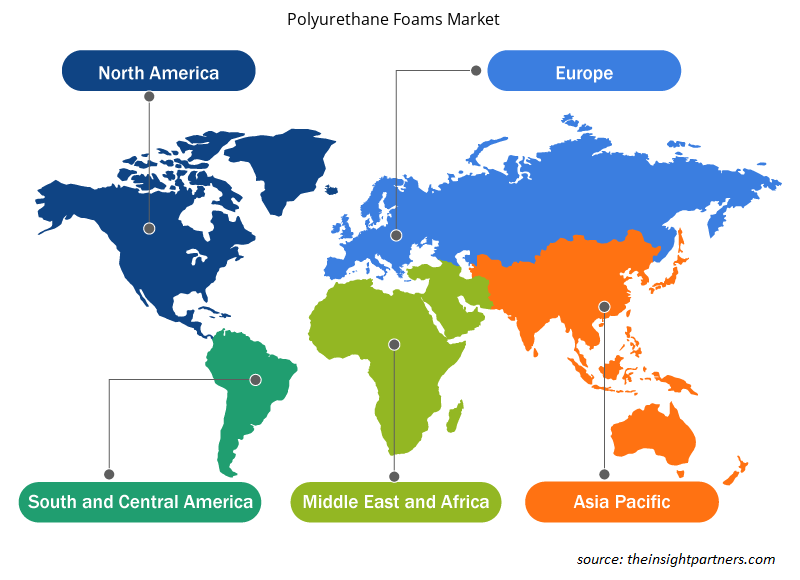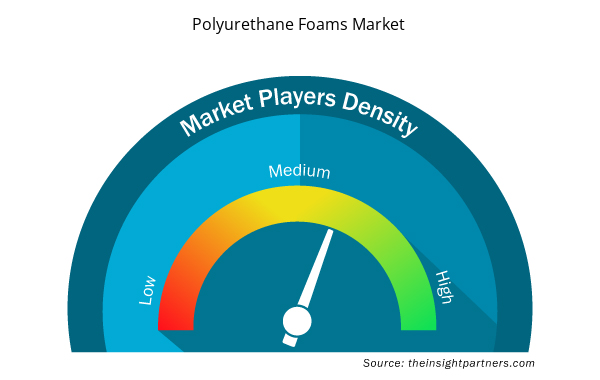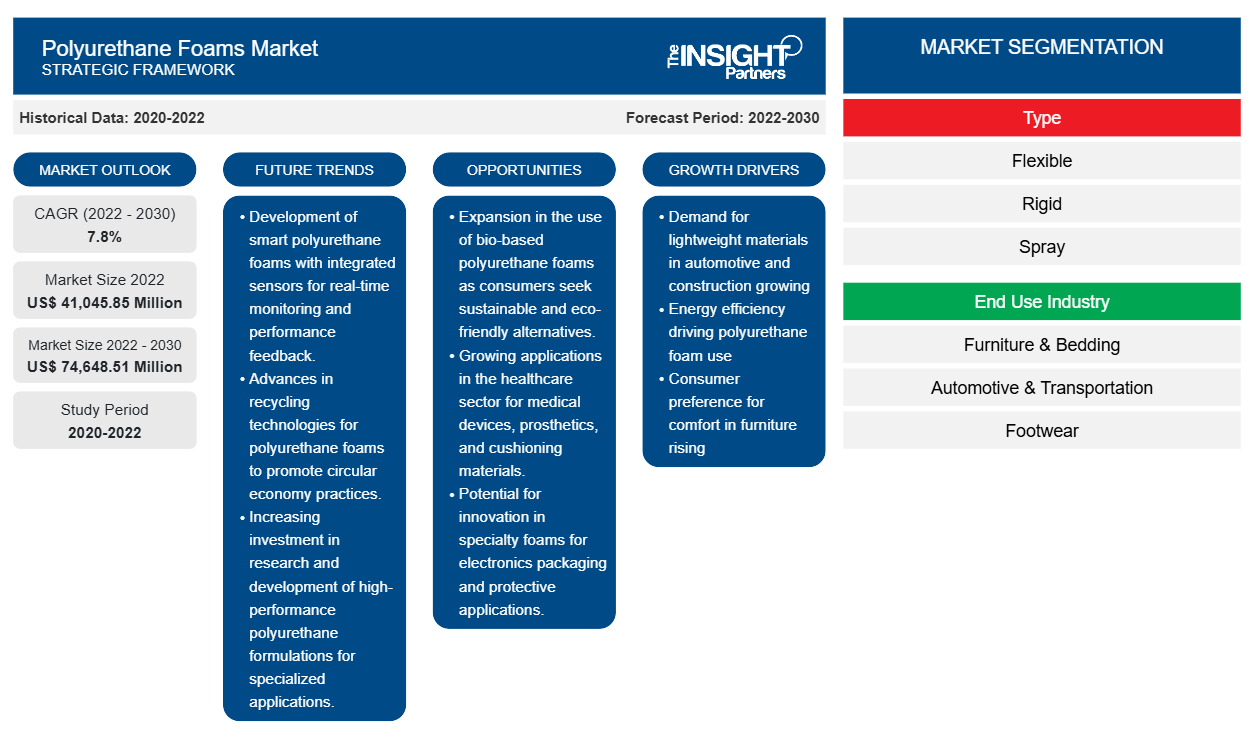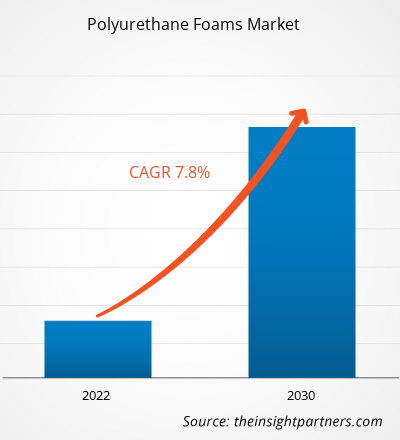[研究报告] 2022 年聚氨酯泡沫市场规模价值 410.4585 亿美元,预计到 2030 年将达到 746.4851 亿美元;预计 2022 年至 2030 年的复合年增长率为 7.8%。
市场分析
聚氨酯泡沫以其多功能性和适应性而闻名,它是一类通过多元醇和二异氰酸酯反应而产生的聚合物。近年来,聚氨酯泡沫市场经历了重大趋势,这得益于技术进步和不断变化的消费者需求。此外,汽车和建筑等行业对轻质高性能材料的需求刺激了聚氨酯泡沫配方的创新。这种化学结合产生了一种具有一系列适用于各种应用的物理和化学特性的材料。软质和硬质是聚氨酯泡沫的两个主要类别。软质泡沫以其弹性和舒适性而著称,广泛应用于软垫家具、床垫和汽车座椅等产品。它们能够贴合身体形状,确保舒适性和耐用性。由于其舒适性和耐用性,市场还见证了软质泡沫应用的增加,特别是在床上用品和家具中。此外,严格的能源效率和建筑标准法规刺激了聚氨酯泡沫用于隔热用途。然而,硬质聚氨酯泡沫在隔热方面表现出色,在建筑行业中发挥着关键作用,可提高建筑物的热效率。所有上述因素都对聚氨酯泡沫市场产生了重大影响。
增长动力与挑战
聚氨酯泡沫在汽车行业有多种用途。在现代汽车内饰中,制造商越来越依赖聚氨酯泡沫来打造符合人体工程学且舒适的座椅解决方案。知名品牌的豪华车型采用聚氨酯泡沫填充座椅,在长途驾驶过程中为乘客提供最佳支撑和舒适度。这体现了泡沫在提升整体驾驶体验方面不可或缺的作用。此外,随着汽车安全性的提高,聚氨酯泡沫在减震部件中的应用也大幅增加。新车型的最新碰撞测试结果和安全评级强调了聚氨酯泡沫在设计车辆内的能量吸收结构方面的战略性使用,减轻碰撞时的冲击力,从而提高乘客的安全性。然而,聚氨酯泡沫不可生物降解,焚烧时会释放有害化学物质,导致污染和潜在的健康风险。因此,制造商面临着越来越大的压力,需要开发传统聚氨酯泡沫的可持续和环保替代品。此外,生产聚氨酯泡沫所用原材料(包括原油和石化产品)的价格波动会影响生产成本,并最终影响泡沫产品的定价。因此,原材料价格波动可能会给制造商管理生产成本和保持市场竞争力带来挑战。
定制此报告以满足您的需求
您可以免费定制任何报告,包括本报告的部分内容、国家级分析、Excel 数据包,以及为初创企业和大学提供优惠和折扣
- 获取此报告的关键市场趋势。这个免费样品将包括数据分析,从市场趋势到估计和预测。
报告分类和范围
“2030 年全球聚氨酯泡沫市场分析与预测”是一项专业而深入的研究,主要关注全球市场趋势和增长机会。该报告旨在概述全球市场,并根据类型、最终用途行业和地理位置对市场进行详细细分。该报告提供了全球聚氨酯泡沫使用情况的关键统计数据,以及主要地区和国家的需求。此外,该报告还对影响主要地区和国家聚氨酯泡沫市场表现的各种因素进行了定性评估。它还包括对聚氨酯泡沫市场主要参与者及其关键战略发展的全面分析。还包括对市场动态的分析,以帮助确定关键驱动因素、市场趋势和有利可图的机会,进而有助于确定主要收入来源。
生态系统分析和波特五力分析提供了全球聚氨酯泡沫市场的360度视角,有助于了解整个供应链和影响市场增长的各种因素。
节段分析
全球聚氨酯泡沫市场根据类型和最终用途行业进行细分。根据类型,聚氨酯泡沫市场细分为软质、硬质和喷涂。软质泡沫在 2022 年占据了最大的市场份额,而喷涂泡沫预计在 2022 年至 2030 年期间的复合年增长率最高。软质泡沫通常用于各种日常应用中,在软垫家具、床垫、汽车座椅和其他注重舒适度的产品中占有重要地位。这些泡沫的灵活性使它们能够适应不同的形状和轮廓,提供最佳的支撑和舒适度。在家具行业,软质聚氨酯泡沫因其保持形状和压缩后反弹的能力而受到青睐,确保了长期的耐用性。根据最终用途行业,聚氨酯泡沫市场细分为家具和床上用品、汽车和运输、鞋类、包装等。 2022 年,家具和床上用品领域占据了聚氨酯泡沫最大的市场份额。在家具领域,聚氨酯泡沫因其出色的耐用性、舒适性和弹性而被广泛用于缓冲和装饰。沙发、椅子和其他软垫家具受益于聚氨酯泡沫提供的支撑和柔软度,确保消费者获得持久的舒适感。此外,其可塑性使其能够实现复杂的设计和形状,使家具制造商能够创造出美观且符合人体工程学的产品。在床上用品领域,聚氨酯泡沫在床垫构造中起着关键作用。记忆泡沫是一种聚氨酯泡沫,可贴合身体轮廓,提供个性化的舒适感和支撑。这一特点推动了记忆泡沫床垫的流行,为许多人带来了更好的睡眠。
区域分析
报告详细概述了全球聚氨酯泡沫市场,涉及五个主要地区——北美、欧洲、亚太地区 (APAC)、中东和非洲 (MEA) 以及南美和中美。亚太地区占全球聚氨酯泡沫市场的很大份额,2022 年的价值超过 90 亿美元。亚太地区是主要汽车和家具制造商的所在地,也是该地区中型企业的中心。预计到 2030 年,欧洲将达到 230 亿美元以上。汽车工业是欧洲经济中增长最快的行业之一。根据欧盟委员会的数据,欧洲是世界上最大的机动车生产国之一。预计北美在 2022 年至 2030 年的复合年增长率将达到约 7%。在北美,乘用车是最常见的交通工具,随着人均收入的增加,其使用量也在增加。随着汽车行业的不断发展和创新,对这些高性能材料的需求不断推动,从而推动聚氨酯泡沫市场的增长。
行业发展和未来机遇
以下列出了聚氨酯泡沫市场的主要参与者采取的各种举措:
2021年6月,巴斯夫与上海哈维斯特保温工程有限公司(Harvest)签署联合开发协议(JDA),利用巴斯夫的Elastopor Cryo聚氨酯硬质泡沫系统生产预制低温管道。
聚氨酯泡沫市场区域洞察
Insight Partners 的分析师已详尽解释了预测期内影响聚氨酯泡沫市场的区域趋势和因素。本节还讨论了北美、欧洲、亚太地区、中东和非洲以及南美和中美洲的聚氨酯泡沫市场细分和地理位置。

- 获取聚氨酯泡沫市场的区域特定数据
聚氨酯泡沫市场报告范围
| 报告属性 | 细节 |
|---|---|
| 2022 年市场规模 | 410.4585亿美元 |
| 2030 年的市场规模 | 746.4851亿美元 |
| 全球复合年增长率(2022 - 2030 年) | 7.8% |
| 史料 | 2020-2022 |
| 预测期 | 2022-2030 |
| 涵盖的领域 | 按类型
|
| 覆盖地区和国家 | 北美
|
| 市场领导者和主要公司简介 |
|
聚氨酯泡沫市场参与者密度:了解其对业务动态的影响
聚氨酯泡沫市场正在快速增长,这得益于终端用户需求的不断增长,而这些需求又源于消费者偏好的不断变化、技术进步以及对产品优势的认识不断提高等因素。随着需求的增加,企业正在扩大其产品范围,进行创新以满足消费者的需求,并利用新兴趋势,从而进一步推动市场增长。
市场参与者密度是指在特定市场或行业内运营的企业或公司的分布情况。它表明在给定市场空间中,相对于其规模或总市场价值,有多少竞争对手(市场参与者)存在。
在聚氨酯泡沫市场运营的主要公司有:
- 科思创公司
- 巴斯夫
- 陶氏
- 亨斯迈集团
- 积水化学工业株式会社
免责声明:上面列出的公司没有按照任何特定顺序排列。

- 了解聚氨酯泡沫市场的主要参与者概况
新冠疫情的影响/地缘政治形势的影响/经济衰退的影响
在新冠疫情爆发之前,全球许多国家都报告了经济增长。主要制造商投资了聚氨酯泡沫的研发。他们还专注于通过并购扩大地理覆盖范围,以满足广泛的客户群。疫情爆发之前,由于汽车行业的需求不断增加,聚氨酯泡沫市场报告了稳步增长。根据美国国际贸易委员会 (USITC) 的数据,由于汽车行业的高度脆弱性,2020 年美国汽车销量与 2019 年相比下降了 15%。在疫情期间,供应链中断、原材料和劳动力短缺以及运营困难造成了供需缺口,对化学品和材料行业的增长产生了不利影响。制造商报告称,从供应商处采购原材料和成分面临挑战,影响了聚氨酯泡沫的生产率。
此外,供应链中断和熟练劳动力短缺导致许多地区(尤其是亚太地区、欧洲和北美)产量下降,并造成供需缺口。由于汽车行业需求波动,多个地区也出现了供需缺口。2021 年,疫苗接种率上升导致不同国家整体状况改善,为化学品和材料行业创造了有利环境。随着汽车行业公司恢复生产和销售业务,聚氨酯泡沫的销量有所增加。这些行业对高质量密封解决方案和垫片材料的需求不断增长,推动了聚氨酯泡沫市场的增长。
竞争格局和主要公司
科思创股份公司、巴斯夫公司、陶氏化学公司、亨斯迈株式会社、积水化学株式会社、圣戈班公司、特瑞堡股份公司、万华化学集团股份有限公司、Recticel SA 和阿科玛是聚氨酯泡沫市场的主要参与者。
- 历史分析(2 年)、基准年、预测(7 年)及复合年增长率
- PEST 和 SWOT 分析
- 市场规模价值/数量 - 全球、区域、国家
- 行业和竞争格局
- Excel 数据集



Report Coverage
Revenue forecast, Company Analysis, Industry landscape, Growth factors, and Trends

Segment Covered
This text is related
to segments covered.

Regional Scope
North America, Europe, Asia Pacific, Middle East & Africa, South & Central America

Country Scope
This text is related
to country scope.
Trends and growth analysis reports related to Chemicals and Materials : READ MORE..
The List of Companies - Polyurethane Foam Market
- Covestro AG
- BASF SE
- Dow
- Huntsman Corporation
- Sekisui Chemical Co. Ltd.
- Saint-Gobain SA
- Trelleborg AG
- Wanhua Chemical Group Co. Ltd.
- Recticel SA
- Arkema
The Insight Partners performs research in 4 major stages: Data Collection & Secondary Research, Primary Research, Data Analysis and Data Triangulation & Final Review.
- Data Collection and Secondary Research:
As a market research and consulting firm operating from a decade, we have published and advised several client across the globe. First step for any study will start with an assessment of currently available data and insights from existing reports. Further, historical and current market information is collected from Investor Presentations, Annual Reports, SEC Filings, etc., and other information related to company’s performance and market positioning are gathered from Paid Databases (Factiva, Hoovers, and Reuters) and various other publications available in public domain.
Several associations trade associates, technical forums, institutes, societies and organization are accessed to gain technical as well as market related insights through their publications such as research papers, blogs and press releases related to the studies are referred to get cues about the market. Further, white papers, journals, magazines, and other news articles published in last 3 years are scrutinized and analyzed to understand the current market trends.
- Primary Research:
The primarily interview analysis comprise of data obtained from industry participants interview and answers to survey questions gathered by in-house primary team.
For primary research, interviews are conducted with industry experts/CEOs/Marketing Managers/VPs/Subject Matter Experts from both demand and supply side to get a 360-degree view of the market. The primary team conducts several interviews based on the complexity of the markets to understand the various market trends and dynamics which makes research more credible and precise.
A typical research interview fulfils the following functions:
- Provides first-hand information on the market size, market trends, growth trends, competitive landscape, and outlook
- Validates and strengthens in-house secondary research findings
- Develops the analysis team’s expertise and market understanding
Primary research involves email interactions and telephone interviews for each market, category, segment, and sub-segment across geographies. The participants who typically take part in such a process include, but are not limited to:
- Industry participants: VPs, business development managers, market intelligence managers and national sales managers
- Outside experts: Valuation experts, research analysts and key opinion leaders specializing in the electronics and semiconductor industry.
Below is the breakup of our primary respondents by company, designation, and region:

Once we receive the confirmation from primary research sources or primary respondents, we finalize the base year market estimation and forecast the data as per the macroeconomic and microeconomic factors assessed during data collection.
- Data Analysis:
Once data is validated through both secondary as well as primary respondents, we finalize the market estimations by hypothesis formulation and factor analysis at regional and country level.
- Macro-Economic Factor Analysis:
We analyse macroeconomic indicators such the gross domestic product (GDP), increase in the demand for goods and services across industries, technological advancement, regional economic growth, governmental policies, the influence of COVID-19, PEST analysis, and other aspects. This analysis aids in setting benchmarks for various nations/regions and approximating market splits. Additionally, the general trend of the aforementioned components aid in determining the market's development possibilities.
- Country Level Data:
Various factors that are especially aligned to the country are taken into account to determine the market size for a certain area and country, including the presence of vendors, such as headquarters and offices, the country's GDP, demand patterns, and industry growth. To comprehend the market dynamics for the nation, a number of growth variables, inhibitors, application areas, and current market trends are researched. The aforementioned elements aid in determining the country's overall market's growth potential.
- Company Profile:
The “Table of Contents” is formulated by listing and analyzing more than 25 - 30 companies operating in the market ecosystem across geographies. However, we profile only 10 companies as a standard practice in our syndicate reports. These 10 companies comprise leading, emerging, and regional players. Nonetheless, our analysis is not restricted to the 10 listed companies, we also analyze other companies present in the market to develop a holistic view and understand the prevailing trends. The “Company Profiles” section in the report covers key facts, business description, products & services, financial information, SWOT analysis, and key developments. The financial information presented is extracted from the annual reports and official documents of the publicly listed companies. Upon collecting the information for the sections of respective companies, we verify them via various primary sources and then compile the data in respective company profiles. The company level information helps us in deriving the base number as well as in forecasting the market size.
- Developing Base Number:
Aggregation of sales statistics (2020-2022) and macro-economic factor, and other secondary and primary research insights are utilized to arrive at base number and related market shares for 2022. The data gaps are identified in this step and relevant market data is analyzed, collected from paid primary interviews or databases. On finalizing the base year market size, forecasts are developed on the basis of macro-economic, industry and market growth factors and company level analysis.
- Data Triangulation and Final Review:
The market findings and base year market size calculations are validated from supply as well as demand side. Demand side validations are based on macro-economic factor analysis and benchmarks for respective regions and countries. In case of supply side validations, revenues of major companies are estimated (in case not available) based on industry benchmark, approximate number of employees, product portfolio, and primary interviews revenues are gathered. Further revenue from target product/service segment is assessed to avoid overshooting of market statistics. In case of heavy deviations between supply and demand side values, all thes steps are repeated to achieve synchronization.
We follow an iterative model, wherein we share our research findings with Subject Matter Experts (SME’s) and Key Opinion Leaders (KOLs) until consensus view of the market is not formulated – this model negates any drastic deviation in the opinions of experts. Only validated and universally acceptable research findings are quoted in our reports.
We have important check points that we use to validate our research findings – which we call – data triangulation, where we validate the information, we generate from secondary sources with primary interviews and then we re-validate with our internal data bases and Subject matter experts. This comprehensive model enables us to deliver high quality, reliable data in shortest possible time.


 获取此报告的免费样本
获取此报告的免费样本